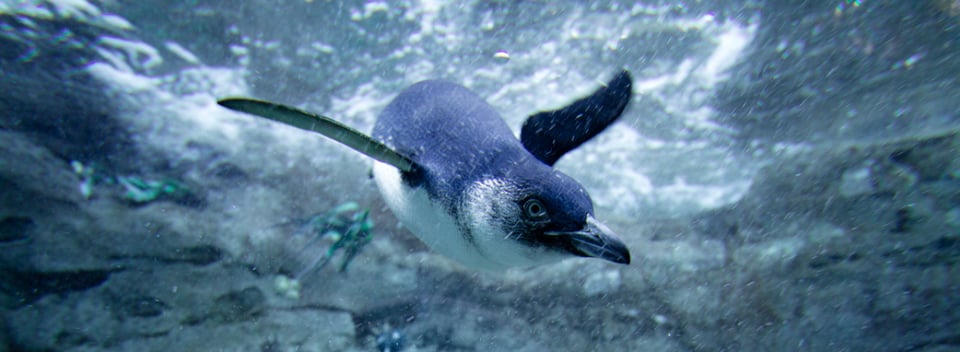
New Zealand Penguins

New Zealand Penguins
New Zealand is home to three very unique species of penguins, some of the rarest penguins in the world. Despite being rare and endangered, they are frequently spotted along the coastlines of the South Island and Stewart Island – if you know where to look! On our New Zealand Trails Tours, your knowledgeable guides will know the best spots to give you the best chance to spot Little Blue Penguins, Yellow-Eyed Penguins, and Fiordland Crested Penguins.
This blog is part of our New Zealand Birds series. To learn more about New Zealand’s special endemic birds, check out our other blogs on native New Zealand parrots (including the kea, kaka and kakapo), and of course our beloved national icon, the kiwi.
Little Blue Penguins
Korora, or the little blue penguin, is the world’s smallest penguin, standing at just 30cm (12inches) tall and weighing about 1kg (2.2lbs). Found around the coastlines of New Zealand and southern Australia, the Little Blues head out to sea to fish during the day, and return to land at night. There are many places you can view Little Blue Penguins making their daily return at dusk, and learn about these special wee penguins and conservation efforts to protect them.

Little Blue Penguin Facts:
- Little Blues are unusual penguins in that they’re capable of raising up to 4 chicks per breeding season. They are able to produce two clutches of two eggs each per year, each of which takes up to 36 days to incubate.
- They are fantastic swimmers, swimming up to 50km per day during breeding season to catch fish for their chicks. They can cover up to 8km per hour in the water, but only stay underwater for 20 to 30 seconds at a time.
- Korora have special glands above their eyes through which they excrete the excess salt from their food.
- Another special gland near their tails produces a “waterproofing” secretion which the penguins rub through their feathers with their beaks. This allows their outer feathers to act as a waterproof and windproof layer while keeping their inner downy feathers nice and dry to act as insulation.
- When they return to shore at dusk each day, Little Blues come ashore in groups called rafts, which can be anywhere between a few penguins to a large raft of over 100 individuals.
- Little Blue Penguins communicate with one another through a variety of calls, allowing them to recognise their mates as well as claim and defend territory.
- Thousands of nesting boxes have been installed in numerous locations around New Zealand to allow the penguins to nest safely away from predation. Programs such as these are crucial in preserving Little Blue Penguin populations and preventing further decline in the numbers.
Yellow Eyed Penguins
Yellow-eyed penguins, or hoiho, are endemic to New Zealand and are one of the rarest penguins in the world. Their scientific name, Megadyptes antipodes, means big diver from the southern lands.

Yellow-eyed penguin facts:
- The Maori name for yellow-eyed penguins, hoiho, translates to noise shouter, and was given to these penguins because of their shrill calls.
- Yellow-eyed penguins do not gain their distinctive yellow eyes until they are around one year old. The yellow colour is caused by carotene, and it is believed that this improves their eyesight, allowing them to be more effective at catching food.
- Hoiho are extremely shy and they prefer to nest far away from other penguins. They primarily build their nests in native coastal forests, scrub or dense flax.
- Yellow-eyed penguins usually mate for life. They are very faithful to their mates and 90% of breeding pairs will reunite each breeding season, unless their partner has died.
- The hoiho is featured on the New Zealand $5 note, recognising its importance as one of our special national birds.
- Yellow-eyed penguins have interlocking outer feather that provide a waterproof layer. These are susceptible to being damaged by oils and other contaminants, are if damaged render the penguin unable to return to the sea as they would no longer have protection from the wet and cold.
- Hoiho are classified as nationally endangered, and are currently one of the most endangered species of penguins in the world with only a few hundred pairs remaining on the New Zealand mainland.
- Despite significant conservation management efforts, their numbers are still in decline. The populations living on the South and Stewart Island have seen a 65% decline in numbers over the past 20 years.
Fiordland Crested Penguins
The Fiordland Crested Penguin, or tawaki, is easily identified by its large bushy yellow “eyebrows”. Endemic to New Zealand, they are found only in small colonies along mostly inaccessible headlands and islets of the southwestern South Island and Stewart Island.

Fiordland Crested Penguin Facts:
- Fiordland crested penguins are about twice as tall, and four times the weight of the Little Blue Penguins, standing 60cm tall and weighing about 4kg.
- They spend much of the year at sea, coming onto land between July and December to breed, and again for a month in late February or early March to moult.
- During their time at sea, tawaki are known to swim several thousand kilometres.
- Fiordland crested penguins expend up to half their body weight during the moulting season, when they fully replace all of their feathers. During this time they are unable to go to sea and are extremely vulnerable to disturbance by humans.
- Tawaki typically lay two eggs during a breeding season. The two eggs are laid about 3 to 6 days apart, with the first egg being smaller than the second. They usually only raise one chick (generally the second, larger egg) despite laying two eggs, however during favourable years a small number of breeding pairs will successfully raise both chicks.
- Fiordland crested penguins are currently classified as nationally vulnerable, and are believed to be the second or third rarest penguin in the world.
Where to see Penguins in New Zealand
New Zealand’s penguins are mostly found on the southern coasts of the South Island, as well as on Stewart Island and the subantarctic islands. All of our South Island tours will take you to areas where you have the opportunity to spot Little Blue, Yellow-Eyed, or Fiordland Crested Penguins.
Little Blue Penguins
- Little Blues are frequently spotted on both the east and west coasts of the South Island. Dunedin, Oamaru and Akaroa are have permanent breeding colonies with conservation programs in place, and all offer penguin spotting tours where you can watch the Little Blue Penguins returning in rafts at dusk.
- Taking a dolphin swim in Akaroa Harbour on our Pure South Tour also provides a great opportunity to see penguins.
- Little Blue Penguins like to nest in the foliage above beaches and are often near beaches. The main highway along the West Coast of the South Island follows the coastline closely, and Little Blue Penguins are often seen near the road. This has resulted in many penguins being hit by cars on the highways, leading local conservation programs to install penguin fences along the roadsides to prevent penguins being run over. If you are travelling down the West Coast while on one of our Masterpiece, World Heritage, or Kiwi Classic Tours, make sure to keep an eye out for Little Blue Penguins!
Yellow-Eyed Penguins
- There are four major breeding regions of yellow-eyed penguins along the southern East Coast of the South Island, as well as on the Stewart Island and the subantarctic Auckland and Campbell Island.
- Your best chances of seeing a yellow-eyed penguin while on one of our tours are on Stewart Island on our New Zealand Great Walk Adventure, or in Akaroa on Banks Peninsula on our Pure South Tour.
Fiordland Crested Penguin
- Tawaki are found on the southwestern region of the South Island, from southern Westland through Fiordland.
- They can be spotted a Munro Beach on the West Coast, where we take a short hike to on our Masterpiece Tour.
- They also have a breeding site at Long Reef Point in Martin’s Bay, at the western end of the Hollyford Track. Our World Heritage Walking Tour takes you on an overnight trip to Martin’s Bay Lodge, where you will walk out to Long Reef Point to visit the seal and penguin colonies there.
- Fiordland crested penguins are also often seen in the outer portions of Milford Sound, which is best accessed by taking a Milford Sound Cruise.
Keen to get a glimpse of one of New Zealand’s rare species of penguins? Join us on a tour of New Zealand’s South Island or Stewart Island and we’ll take you to the best off-the-beaten-track spots where you might be able to get up close to these unique creatures. Request a FREE COPY OF OUR BROCHURE here to find out more.








Comments
Let’s talk – we’d love to hear what you think. Pop your details in below and have your say.
No one has commented on this page yet.
RSS feed for comments on this page | RSS feed for all comments